Holistic SEO
The Rise of Visual Search: Optimizing Images for SEO
Prepare to unlock the secrets of visual search optimization for SEO and discover how to elevate your online presence effectively.
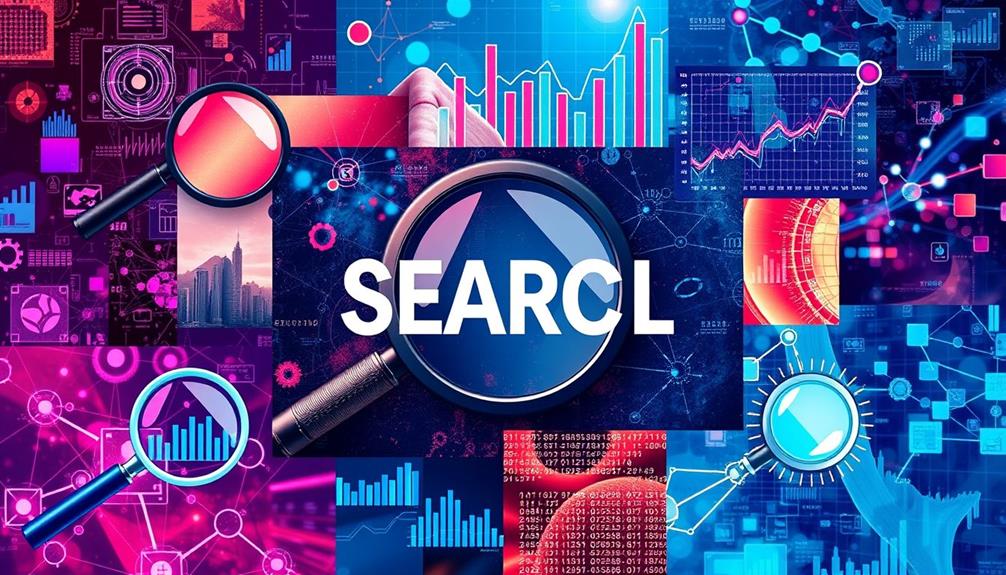
Optimizing images for SEO is essential as visual search technology changes how you find and interact with content. With 62% of Millennials and Gen Z favoring visual searches, using high-quality visuals and relevant metadata enhances user engagement and boosts your visibility. Focus on descriptive file names, alt text, and structured data markup to help search engines understand your images better. Keep your file sizes under 100 KB for faster loading times. Staying ahead in this evolving landscape will keep you competitive and improve your connection with users. To further enhance your strategies, there's more to explore.
Key Takeaways
- Visual search has gained popularity, with 62% of younger consumers preferring image-based queries over traditional text searches.
- Optimizing images with descriptive file names and relevant alt text enhances SEO and improves search engine indexing.
- High-quality visuals significantly boost user engagement, increasing click-through rates by up to 30%.
- Implementing structured data markup provides context for images, aiding search engines in understanding content.
- Keeping image file sizes under 100 KB and utilizing efficient formats like SVG and WEBP enhances loading speed and user experience.
Understanding Visual Search
How does visual search change the way you find information? It's revolutionizing your search experience by letting you use images instead of text-based queries. This shift reduces ambiguity in what you're looking for, making it easier to find exactly what you need.
As of 2022, 62% of Millennials and Gen Z prefer visual search, highlighting a significant change in consumer behavior. Platforms like Google Lens and Pinterest Lens are leading this movement, with Google Lens alone recording a staggering 8 billion searches each month.
AI advancements raise significant interest in how we interact with technology, particularly in enhancing user experiences.
Visual search technology utilizes AI and machine learning to analyze visual attributes—like colors and shapes—enhancing the accuracy of image recognition. This means you're likely to find more relevant results tailored to your preferences.
To navigate this new landscape effectively, you'll want to focus on optimizing images for visual search. By doing so, you help search engines better understand your content, ensuring your visuals resonate with users who are increasingly relying on images to find information quickly.
As mobile devices with advanced cameras become more prevalent, embracing visual search is essential for staying ahead in this evolving digital environment.
Visual Search Vs. Image Search

When you compare visual search and image search, you'll notice some key differences in methodology.
Visual search lets you use images directly to find what you need, while image search relies on text queries to generate results. This shift not only affects how users engage but also impacts the accuracy of search results you receive.
Additionally, optimizing images for SEO can enhance user experience and improve content discoverability, as search engines are increasingly favoring well-structured content clusters for indexing.
This makes understanding strategies for increasing topical authority essential for leveraging visual search effectively.
Methodology Differences Explained
Visual search and image search represent two distinct methodologies for retrieving visual content, each tailored to different user needs. Understanding these differences can enhance your approach to optimizing images for visual search.
Astrology suggests that certain personality traits may influence how users interact with visual content, impacting their preferences and choices. This aligns with the idea that astrological compatibility can affect romantic interests, extending to how individuals might engage with visual elements online.
- Query Method: Visual search uses images as queries, while image search relies on text input.
- Technology: Visual search capabilities leverage computer vision and AI to analyze visual attributes, whereas image search depends on metadata and text relevance.
- User Experience: For instance, scanning an image of a "blue denim jacket" yields results based on visual features, while typing the same terms retrieves text-based results.
- User Behavior Shift: A significant 62% of Millennials and Gen Z prefer visual search, showcasing a trend toward image-based queries.
As you optimize images for visual search, focus on enhancing their visual attributes and ensuring they're indexed correctly.
Understanding these methodological differences will help you align your content with evolving user behavior, ultimately improving your visibility in an increasingly visual-centric digital landscape.
User Engagement Patterns
Engagement patterns have shifted greatly as users increasingly favor visual search over traditional image search methods. You'll notice that 62% of Millennials and Gen Z prefer visual search, demonstrating a clear trend towards image-based queries. This preference is largely due to the quick and intuitive results visual search delivers.
Moreover, the rise of e-commerce has amplified the need for efficient credit card processing, making visual content even more essential for online businesses targeting these demographics. By allowing users to upload or scan images, you can see how this method leads to higher engagement compared to the text-heavy approaches of traditional image searches, as the importance of understanding credit card impacts on personal finances becomes clearer in the context of online shopping.
Research shows that visual content can boost engagement rates by up to 94%, revealing its effectiveness in capturing user attention. With platforms like Google Lens reporting 8 billion searches per month, it's evident that more users are relying on visual search functionalities.
Additionally, Pinterest Lens alone generates over 600 million searches monthly, underscoring the demand for interactive image-based search experiences.
To capitalize on these user engagement patterns, you must refine your optimization strategies. By focusing on high-quality visuals and relevant metadata, you can enhance your visibility in visual search results and meet the changing preferences of your audience.
Search Result Accuracy
Search result accuracy is essential in today's digital landscape, where users expect quick and relevant information. Visual search is taking this to the next level by utilizing images as queries, greatly improving accuracy compared to traditional image search that relies on text inputs.
This shift in search technology emphasizes the need for meticulous testing and quality assurance, similar to the best practices in software quality assurance that guarantee software meets high-quality standards.
Here are four key benefits of visual search accuracy:
- Enhanced Matching: Visual search analyzes visual characteristics, leading to more precise results.
- Increased Engagement: Users are 60% more likely to engage with results that match their image queries.
- Reduced Ambiguity: Visuals help clarify search intents, with 70% of consumers relying on images for buying decisions.
- Growing Demand: With 27% of all Google searches being image-based, the need for accurate visual results is clear.
As search engines index images more effectively, you need to optimize images for visual search to stay competitive.
This evolution in technology not only meets user expectations but also enhances the relevance of search results. By understanding the dynamics of visual search, you can capitalize on its potential and increase your visibility in a crowded digital space.
Popular Platforms for Visual Search
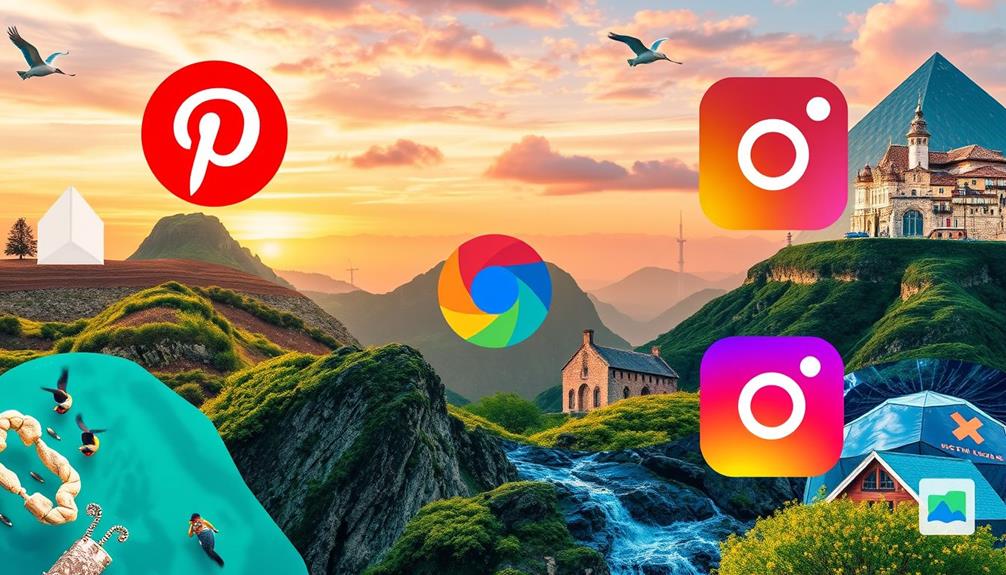
Today, a variety of platforms are revolutionizing how we interact with images and retrieve information. As you explore visual search engines, you'll notice that each platform offers unique features tailored to different needs.
| Platform | Monthly Searches | Notable Features |
|---|---|---|
| Google Lens | 8 billion | Search using images for various info |
| Pinterest Lens | 600 million | Visual inspiration and product discovery |
| Amazon Visual Search | N/A | Augmented reality for product visualization |
Google Lens leads the way with approximately 8 billion searches per month, allowing users to search for diverse information using images. Pinterest Lens captures over 600 million searches monthly, perfect for those seeking visual inspiration. Bing Visual Search offers customization options for developers while integrating visual search capabilities into its search engine.
Amazon Visual Search enhances shopping experiences by using augmented reality, allowing customers to visualize products in their environment before buying. The rapid growth of these platforms emphasizes the importance of optimizing for visual search. Adopting visual search optimization strategies is essential for staying ahead in this evolving landscape.
Image Quality and Structure

When it comes to visual search, high-quality images are key to grabbing attention and enhancing user experience.
Additionally, employing features such as a self-cleaning mechanism for vacuums can improve efficiency in cleaning tasks, much like optimizing images enhances website performance.
You should also utilize structured data markup and effective image file naming to help search engines understand your visuals better.
Importance of High-Quality Images
High-quality images play an important role in capturing attention and driving engagement, making them essential for effective visual search optimization. When you use high-quality images, you can markedly enhance user interaction and influence decisions.
Additionally, incorporating visuals that reflect a variety of perspectives on healthy living trends can further attract a diverse audience. Here's why you should prioritize image quality:
- Engagement Rates: High-quality visuals can boost engagement rates by up to 94%, making your content more appealing.
- Optimization Size: Optimize images to a maximum size of 100 KB to guarantee fast loading times without sacrificing quality.
- File Formats: Use appropriate formats like SVG and WEBP to improve performance and load speed, essential for user experience and SEO rankings.
- Element Positioning: Clearly position logos and key features within images to enhance recognition by both search engines and users, improving search context.
Structured Data Markup
Incorporating structured data markup into your image optimization strategy is vital for enhancing visibility in search results. This technique provides additional context for your images, helping search engines understand their content better. By utilizing schema markup, you can enhance rich snippets, making your visuals stand out in search engine results pages (SERPs) and attract more clicks.
Additionally, using high-quality images of vibrant foods, such as those found in juicing recipes, can greatly enhance user engagement and interest. When you're optimizing images, remember that high-quality visuals combined with proper structured data can lead to a remarkable 30% increase in click-through rates. This added context not only improves user engagement but also boosts your chances of appearing in Google's Knowledge Graph, further elevating your online presence.
Moreover, it's essential to guarantee your images are optimized in size, format, and resolution. This not only maintains fast loading speeds but also contributes to a positive user experience. By effectively implementing structured data markup, you're not just enhancing visibility; you're also making your content more accessible and appealing to both users and search engines.
Effective Image File Naming
Optimizing your image file names can greatly improve your site's SEO performance. When you focus on effective image file naming, you're not just enhancing visibility; you're also making it easier for search engines to understand your content.
Studies indicate that user behavior, such as the way they interact with images, can impact SEO as well, so guaranteeing your images are relevant and well-optimized is essential for engagement.
Here are some tips to keep in mind:
- Use Descriptive File Names: Include relevant keywords that accurately reflect the image content (e.g., "blue-denim-jacket.jpg").
- Separate Words with Hyphens: Opt for hyphens instead of underscores, as search engines read hyphens as spaces, improving indexing.
- Keep It Concise: Aim for 3-5 words per file name to enhance user comprehension and search engine efficiency.
- Optimize File Sizes: Make certain high-quality images are under 100 KB for faster loading times, which positively impacts user experience and SEO.
Additionally, understanding how cats show signs of separation anxiety can help you create more relatable content that resonates with your audience.
Technical Optimization Strategies

Technical optimization strategies play an essential role in enhancing your website's visual search performance. Start by implementing structured data markup for your images. This helps search engines understand the context of your visual content, boosting its visibility and improving indexing accuracy.
Additionally, consider using air purifier features to highlight the benefits of your products through relevant images. Next, don't underestimate the power of alt text. Use descriptive alt text that includes relevant keywords; this not only aids search engines in categorizing your images but also improves accessibility for visually impaired users.
Another critical aspect is image file size. Keep your images under 100 KB to guarantee faster loading times, which helps maintain user engagement and positively impacts your search rankings.
Additionally, choose the right file formats like SVG and WEBP; these formats enhance image quality while offering better compression.
User Behavior Trends

Frequently, users are gravitating towards visual search as their preferred method of finding information online. This trend highlights a significant shift in user behavior, driven by the demand for instant information and engaging content.
Here are some key insights into these user behavior trends:
- Preference for Visuals: 62% of Millennials and Gen Z favor visual search over traditional text-based methods, showing a clear inclination towards images.
- Instant Information: A staggering 70% of consumers believe images are essential in their buying decisions, underscoring the importance of visual content in user engagement.
- Mobile Influence: With 27% of searches being image-based, mobile device usage is reshaping how users interact with online content.
- Social Media Impact: Social platforms drive visual discovery, with 80% of visual content shared there, further influencing search preferences.
As you optimize images for SEO, keep these trends in mind.
Users want quick, visually appealing information, and adapting to these preferences can enhance your content's visibility and user engagement.
Embrace visual search today to stay ahead in the evolving digital landscape!
Challenges in Visual Search Optimization

While visual search offers exciting opportunities for enhancing online visibility, it also presents several challenges that businesses must navigate to succeed. One major hurdle in visual search optimization is ensuring you have large volumes of high-quality, relevant images. Search engines depend on properly tagged images for effective image recognition, making it critical to maintain quality.
Integrating structured data to boost image recognition adds complexity and can be time-consuming, particularly as machine learning technologies evolve. Plus, as more businesses adopt visual search strategies, competition intensifies, requiring you to optimize images effectively alongside traditional SEO techniques to stand out.
Local SEO integration can further complicate matters. You need to optimize images for location-specific queries, which involves additional tagging and metadata management.
Finally, staying updated with new features and changes on platforms like Google Lens and Pinterest Lens is essential. Regularly adapting your strategies keeps your visual search efforts effective, but it also demands ongoing commitment and resources.
Embracing these challenges with a proactive approach will ultimately help you succeed in the dynamic landscape of visual search.
Future of Visual Search Technology

As visual search technology evolves, you'll find advancements in AI playing a vital role in shaping your search experience.
With user expectations shifting towards faster and more accurate results, visual search is becoming a game changer in how you discover information.
It's clear that the future will rely heavily on images, making it essential for you to stay ahead in this rapidly changing landscape.
Advancements in AI
Advancements in AI are revolutionizing the future of visual search technology, making it easier for you to find exactly what you're looking for through images rather than text.
With the rise of machine learning algorithms and deep learning, the accuracy of image recognition is improving, leading to more relevant search results. Here are some key developments to watch:
- Enhanced Image Recognition: AI tools like Google TensorFlow allow for sophisticated neural networks that analyze complex image data.
- Personalized Search Results: Future visual search platforms will use context-aware algorithms tailored to your preferences and behavior.
- Augmented Reality Integration: You'll soon interact with products virtually, thanks to AR capabilities in visual search technology.
- Shift to Image-Based Queries: Experts predict a move away from traditional text-based searches, prioritizing visual queries for a more intuitive experience.
As these advancements in AI unfold, expect a paradigm shift in how you retrieve online information, making visual search a powerful tool for your needs.
Embrace these changes to enhance your search experience and stay ahead in the evolving digital landscape.
Evolving User Expectations
Visual search technology is reshaping how you interact with online content, driven by your evolving expectations for quick and visually engaging information.
With 62% of Millennials and Gen Z favoring visual searches over traditional text-based methods, it's vital for businesses to adapt their strategies. You'll likely notice a significant shift where images take precedence over keywords in online searches, fundamentally changing how you seek information.
As mobile devices and high-quality smartphone cameras become ubiquitous, your engagement with visual content increases, pushing demand for accessible and appealing information.
Enhanced AI and machine learning capabilities are continuously refining visual search accuracy and speed, providing you with instant gratification. This means you expect to find what you're looking for faster and more efficiently than ever before.
Social media platforms are playing a pivotal role in this trend, as 80% of visual content is shared there, reflecting your desire for engaging visuals.
By optimizing images effectively, businesses can meet your expectations and enhance your online experience.
As visual search technology evolves, staying attuned to these shifts will empower you to find more relevant and enthralling content effortlessly.
Community Engagement Strategies

Effective community engagement strategies are essential for fostering a vibrant network around visual search optimization. By actively involving your audience, you can create a supportive environment that drives knowledge sharing and collaboration.
Here are four effective strategies to enhance community engagement:
- Monthly Emails: Send out valuable insights on visual search optimization to empower your subscribers. This fosters knowledge sharing and keeps your community informed.
- Free Website Analysis: Offer complimentary SEO audits to potential clients. This not only showcases your expertise in visual search strategies but also builds connections.
- Webinars: Host interactive webinars or virtual workshops focused on optimizing images for visual search. These sessions encourage participation and create a space for learning.
- Social Media Engagement: Actively engage with your community on social media platforms. Facilitate discussions, gather feedback, and share success stories related to visual search optimization.
Implementing these strategies can greatly enhance community engagement, creating a loyal network that supports each other in mastering visual search optimization.
Long-Term Benefits of Optimization

Embracing image optimization isn't just a trend; it's a strategy that can greatly affect your long-term success. By optimizing images for SEO, you're not only enhancing user engagement—think a 94% increase in engagement rates—but also setting the stage for long-term visibility in search results.
With 70% of consumers indicating that images influence their purchasing decisions, investing in visual search optimization becomes essential for attracting and retaining customers.
Effective image optimization also boosts your search engine rankings, especially as Google reports that 27% of searches are now image-based. This growing reliance on visual content means that your efforts can pay off considerably.
Utilizing structured data alongside optimized images helps search engines better understand and categorize your visuals, guaranteeing they appear prominently in relevant searches.
Moreover, by continuously adapting to visual search trends, you position your business as an industry leader. This adaptability not only fosters customer loyalty but also guarantees sustained growth in a competitive digital landscape.
In the long run, the benefits of optimizing images extend beyond immediate gains, establishing a solid foundation for your brand's visibility and influence.
Conclusion
As visual search technology evolves, optimizing your images is like planting seeds in a digital garden; the effort you put in now will bloom into long-term benefits. By understanding visual search's nuances and implementing effective strategies, you'll not only enhance your visibility but also engage your audience more effectively. Embrace the future of search, stay ahead of the curve, and watch your online presence flourish like a vibrant spring meadow.
Chris, SEO and Keywords Expert & Author: Chris lives and breathes SEO. With a deep understanding of keyword research and strategy, he’s our go-to guru for everything related to search rankings. Chris has a knack for identifying trends and opportunities in the SEO world, making him an invaluable asset to our team and our clients.
Holistic SEO
Zero-Click Searches: Adapting to the New SERP Landscape
Unlock the secrets to thriving in the era of zero-click searches and discover how to optimize your content for the new SERP landscape.

Zero-click searches are changing the way users interact with search engine results. Over 50% of Google searches now yield answers directly on the SERP, eliminating the need for clicks. To adapt, focus on optimizing for featured snippets and knowledge panels. Use structured data markup to enhance recognition by search engines. Long-tail keywords should be a priority, as they align better with user intent. Maintaining accuracy and credibility in your content is essential; users seek reliable information. As you adjust your SEO tactics, you'll find more strategies to thrive in this evolving landscape.
Key Takeaways
- Over 50% of Google searches result in zero-click interactions, necessitating new SEO strategies focused on featured snippets and knowledge panels.
- Optimizing for long-tail keywords and local search can enhance content discoverability and better meet user intent.
- Implementing structured data markup increases the likelihood of appearing in rich snippets and improves search engine interpretation.
- Accuracy and credibility are vital, as 70% of featured snippets come from authoritative sources, influencing user trust.
- Continuous keyword performance monitoring is essential for adapting SEO tactics to the evolving landscape of search algorithms.
Understanding Zero-Click Searches
Zero-click searches have revolutionized the way we find information online. These searches occur when you get immediate answers directly on the search engine results page (SERP) without needing to click on any links. As of 2023, over 50% of Google searches fall into this category, showcasing a significant shift in user behavior.
Formats like featured snippets, knowledge panels, and direct answer boxes cater to your need for quick information retrieval. This trend emphasizes the importance of keyword clustering and topic clustering to enhance content discoverability.
The rise of zero-click searches is largely driven by advanced Google algorithms that understand user intent more effectively than ever before. With an increase in mobile searches and voice queries, people are seeking fast answers rather than browsing multiple links. In fact, 64.82% of Google searches in 2020 resulted in zero clicks, underscoring this trend.
While zero-click searches provide convenience, they also pose challenges for businesses. You might notice reduced organic traffic and engagement, which means adapting your search engine optimization (SEO) strategies is essential.
Emphasizing structured data and aiming for featured snippets can enhance your visibility on SERPs, helping you navigate this new landscape effectively.
Impact on SEO Strategies
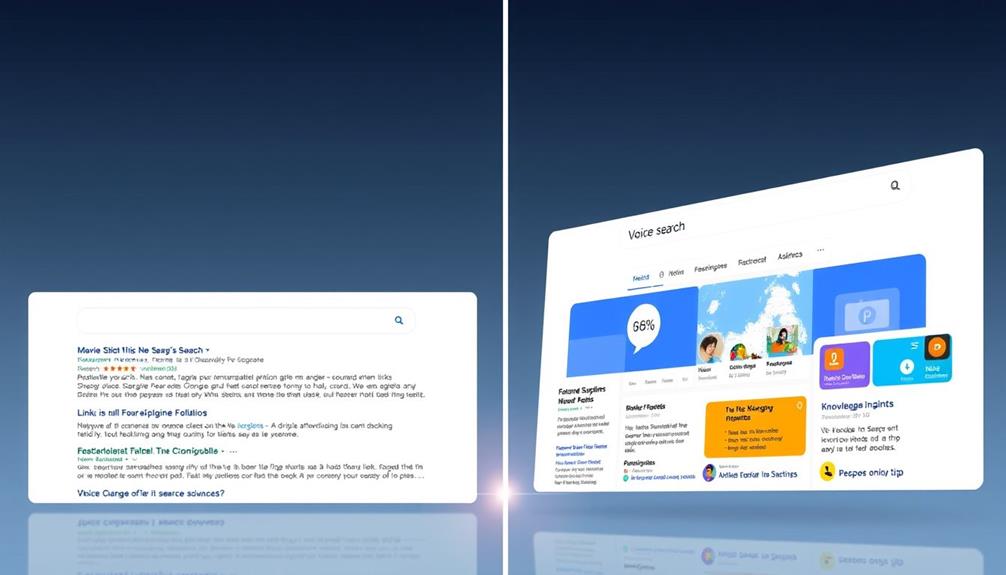
The rise of zero-click searches has fundamentally altered how businesses approach their SEO strategies. With over 50% of Google searches now classified as zero-click, your focus needs to shift from merely generating traffic to delivering concise, authoritative information directly on search engine results pages.
This shift is particularly important for small businesses looking to enhance their visibility and engagement through effective email marketing strategies. Prioritizing featured snippets and knowledge panels is vital; guarantee your content is structured clearly with headings and lists to enhance your chances of being displayed.
Monitoring keyword performance continuously is significant, as traditional high rankings may no longer guarantee increased website clicks. Instead, adapt by focusing on long-tail keywords and optimizing for local search results. These strategies can still drive user engagement, even amid declining click-through rates.
Utilizing structured data markup is another way to boost your content's visibility. This technique can improve your chances of appearing in rich snippets, catering to the new user search intent that values instant information retrieval.
Ultimately, adjusting your SEO strategies to align with the impact of zero-click searches will be key to staying relevant and effective in today's digital landscape.
Types of Content Affected

Search results now often deliver immediate answers, drastically changing how users interact with information online. Zero-click searches mainly affect informational queries, where you're likely seeking quick responses without clicking through to websites. In fact, about 64.82% of searches yield no clicks at all.
The rise of content formats like featured snippets, knowledge panels, and direct answer boxes has become essential in this landscape, providing you with immediate answers right on the search engine results page. For instance, the value of home security systems can be quickly summarized in a snippet, making it easily accessible for users seeking information on safety measures.
While long-form content still holds relevance for in-depth topics, its traffic may decline as users find quick answers to simpler queries. This shift in user behavior, with 50% of Google searches resulting in immediate answers, highlights the need for adapting your SEO strategy.
To enhance visibility in zero-click results, effectively utilizing structured data is critical, as it improves how search engines understand your content.
Ultimately, recognizing the types of content affected by zero-click searches is essential for staying relevant. Adjusting your content formats to include quick, concise answers can help meet the evolving needs of users seeking immediate information.
Importance of Accuracy and Credibility

When you're aiming for success in zero-click searches, identifying trustworthy sources is key.
Companies like Noble Gold and Augusta Precious Metals emphasize transparency and customer satisfaction, which can serve as valuable benchmarks for credibility.
You need to prioritize research and fact-checking to guarantee your information is accurate, as this can greatly impact user trust.
Trustworthy Source Identification
Often, users rely on the accuracy and credibility of information presented in zero-click searches, making trustworthy source identification fundamental.
With the rise of AI-generated content, it's essential to guarantee that the information provided isn't only accurate but also ethically sourced, as ethical considerations are significant in educational data mining.
To guarantee that you're delivering credible content, focus on the signals search engines use, such as domain authority and backlink profiles. These factors determine which sources are selected for featured snippets and answer boxes, greatly impacting visibility.
A study revealed that 70% of featured snippets come from pages recognized as authoritative. This highlights the importance of using verifiable information and establishing your site as a trustworthy source.
When users encounter high-quality content from credible sources, it enhances their trust in your brand. In fact, 87% of users prefer results from sources they can trust, which reinforces the necessity for a solid reputation.
Research and Fact-Checking
In the domain of zero-click searches, the accuracy and credibility of information are paramount. Search engines prioritize trustworthy sources for featured snippets and direct answers, which greatly impacts your content visibility. To guarantee your content stands out, focus on providing verifiable information through thorough research and fact-checking.
| Element | Importance | Strategy |
|---|---|---|
| Accuracy and Credibility | Essential for trust | Use authoritative sources |
| Verifiable Information | Enhances chances of featuring | Cite reliable data |
| User Intent | Aligns content with needs | Monitor analytics for insights |
| High-Quality Content | Builds authority and trust | Create engaging and informative content |
Referencing authoritative sources not only bolsters your claims but also improves your content's reliability in the eyes of search engines. Monitoring analytics helps you identify queries leading to zero-click interactions, allowing for better alignment with user intent. Ultimately, high-quality, accurate content is vital in an environment where users seek instant, reliable information without needing to navigate to a website.
Impact on User Trust
User trust hinges greatly on the accuracy and credibility of the information provided in zero-click search results. When users rely on instant answers from search engines, your content must stand out as trustworthy. For instance, essential oils for hair growth can provide invaluable insights for users seeking natural solutions.
Here are four key factors that influence user trust in this new landscape:
- Accurate Information: Users expect the information presented in featured snippets to be precise and reliable.
- Authoritative Sources: Citing credible publications enhances your visibility and boosts user trust, as search engines prioritize content from reputable sources.
- Fact-Checking: Thoroughly researching and verifying your content establishes credibility and prevents the spread of misinformation, which can quickly erode user trust.
- Engagement with Zero-Click Searches: With over 50% of Google searches classified as zero-click, it's vital to guarantee that the information you provide meets the highest standards of accuracy.
In this environment, any inaccuracies can undermine your brand reputation. Consequently, focusing on delivering trustworthy, accurate information is fundamental to maintaining and enhancing user trust in your content.
Emphasizing these aspects not only benefits your audience but also positions your brand as a reliable source in the ever-evolving search landscape.
Adapting Your SEO Approach
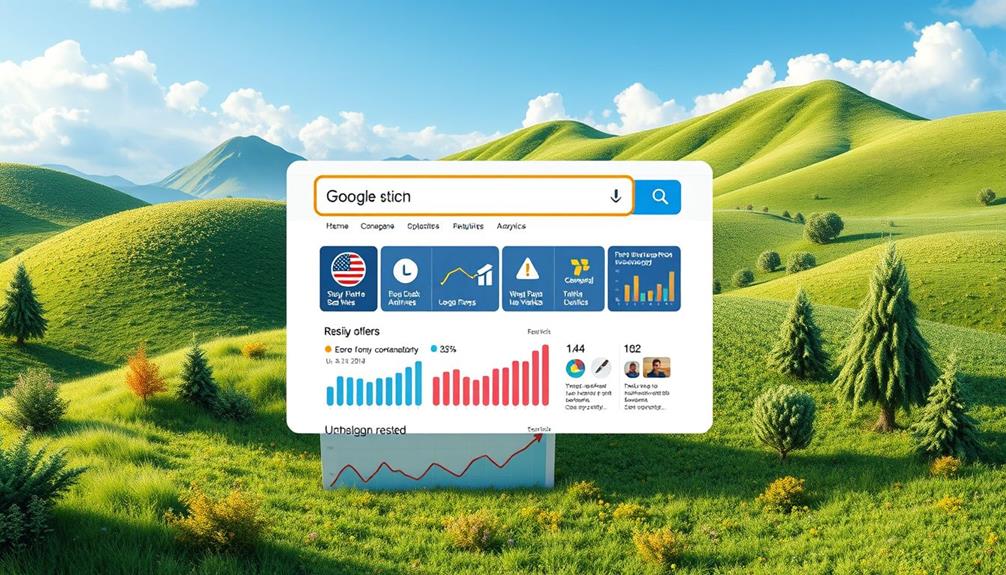
To successfully adapt your SEO approach for zero-click searches, it's crucial to prioritize optimization for featured snippets. Start by structuring your content to directly and clearly answer common questions, making it easier for search engines to pull your information.
Implement structured data markup to enhance how search engines interpret your content, increasing your chances of appearing in rich snippets or knowledge panels. Additionally, leveraging social media platforms can help in promoting your content and driving traffic, complementing your SEO efforts.
Focus on long-tail keywords that align with specific user intent. These keywords are more likely to trigger zero-click search results and featured snippets, which can boost your visibility.
Regularly monitor your keyword performance using tools like Google Search Console to identify which queries lead to zero-click interactions. This data will help you refine your content strategy and make necessary adjustments.
Additionally, enhance your local SEO efforts by claiming and optimizing your Google My Business profile. Local packs remain a crucial traffic source for businesses, even with the rise of zero-click searches.
Future Trends in SEO

As zero-click searches reshape the digital landscape, staying ahead in SEO means understanding the future trends that will influence how users interact with search engines.
Attention to detail in your content strategy is critical for optimizing visibility, especially as trends evolve. Here are four key trends to watch:
- Optimization for Featured Snippets: With over 50% of searches resulting in zero-click interactions, focusing your SEO strategies on obtaining featured snippets can dramatically enhance your brand visibility.
- Rise of Voice Search: As voice-activated devices gain traction, your content strategies need to adapt to cater to conversational queries, ensuring you meet user intent effectively.
- Emphasis on Local SEO: Local packs are driving significant traffic, making it essential to maintain accurate Google My Business profiles and encourage positive reviews to capture local searches.
- AI and Machine Learning Integration: As search algorithms evolve through AI and machine learning, they'll better understand user intent.
This necessitates that you continuously refine your SEO tactics to align with these advancements, similar to the importance of quality assurance in software development.
Conclusion
As you navigate the shifting landscape of zero-click searches, remember that 50% of all searches now result in zero-click outcomes. Adapting your SEO strategy is essential to staying relevant and visible. Focus on providing accurate, credible content that answers users' queries directly. By embracing these changes and optimizing for this new SERP environment, you can guarantee your brand remains a trusted resource amidst the evolving digital landscape. Don't get left behind; evolve with the search engines!
Chris, SEO and Keywords Expert & Author: Chris lives and breathes SEO. With a deep understanding of keyword research and strategy, he’s our go-to guru for everything related to search rankings. Chris has a knack for identifying trends and opportunities in the SEO world, making him an invaluable asset to our team and our clients.
Holistic SEO
Green SEO: Optimizing for Sustainability-Conscious Consumers
Maximize your online impact with Green SEO strategies that attract sustainability-conscious consumers—discover how to make your brand stand out today.

To attract sustainability-conscious consumers, you need to embrace green SEO strategies that focus on eco-friendly optimization. Start with energy-efficient web hosting and coding, which can reduce your site's energy consumption considerably. Create high-quality, evergreen content that resonates with eco-conscious values while optimizing site speed for a better user experience. Utilize keyword clustering for relevant topics and guarantee your site is mobile-friendly. Engaging in social media and fostering community ties enhances visibility. By implementing these practices, you can boost brand trust and loyalty. There's much more to explore in making your online presence greener.
Key Takeaways
- Implement green web hosting and efficient coding practices to reduce energy consumption and improve website performance for sustainability-conscious consumers.
- Create high-quality evergreen content focused on eco-friendly topics to attract eco-conscious audiences and enhance organic search rankings.
- Optimize images and utilize responsive design to improve mobile loading times, catering to the increasing number of consumers using mobile devices.
- Incorporate sustainable messaging across digital marketing channels to build brand trust and attract consumers willing to pay more for eco-friendly products.
- Regularly audit site performance and user engagement metrics to align with sustainability goals and enhance the overall user experience.
Understanding Green SEO
Green SEO is all about optimizing your website with eco-friendly practices that resonate with today's environmentally conscious consumers. By adopting sustainable practices, you can notably lower your digital footprint and enhance your brand's appeal.
This entails using eco-friendly SEO practices that prioritize energy-efficient web hosting and coding to reduce your overall carbon footprint. Incorporating renewable energy strategies, like geothermal energy applications, can further position your brand as a leader in sustainability.
To truly grasp Green SEO, you should focus on creating high-quality evergreen content that aligns with sustainability themes. Google's algorithms are increasingly favoring websites that showcase environmental responsibility, so integrating eco-centric keywords into your content can boost your search rankings.
Additionally, consider the impact of your website's speed; a fast-loading site not only improves user experience but also contributes to lower energy consumption. This is a vital aspect of optimizing your website for eco-conscious users.
Benefits of Sustainable Practices

As more consumers prioritize sustainability, adopting eco-friendly practices in your SEO strategy can greatly enhance your brand's appeal. By implementing sustainable SEO practices, you can reduce your website's energy consumption by 20-30%, directly benefiting both your environmental impact and operational costs.
This commitment to sustainability can attract up to 76% of eco-conscious consumers who prefer brands that align with their values, boosting customer loyalty and engagement. In addition, utilizing AI security measures can protect sensitive data while supporting sustainable practices through efficient resource management.
Websites that focus on energy efficiency often experience faster loading speeds, which can improve search rankings by up to 15%. This not only elevates your SEO success but also enhances user experience and retention.
Additionally, integrating green messaging into your content can lead to a 50% increase in organic traffic, especially when targeting environmentally focused keywords.
Moreover, companies showcasing their commitment to sustainability see a remarkable 30% increase in brand trust among consumers. This trust considerably influences purchasing decisions and brand preference.
Implementing Eco-Friendly Strategies

To truly capitalize on the benefits of sustainable practices, you need to implement eco-friendly strategies in your SEO efforts. Start by choosing green web hosting services that utilize renewable energy sources, which can greatly reduce your website's carbon footprint.
Additionally, consider the importance of keyword clustering to enhance your site's relevance and discoverability, aligning your content with sustainable topics that attract eco-conscious consumers.
Next, optimize your website's efficiency by compressing images and minimizing code. This not only enhances loading times but also decreases energy consumption, aligning perfectly with eco-friendly practices.
Embrace sustainable web design principles by adopting minimalistic designs and optimizing multimedia content. These strategies contribute to lower energy usage and greatly improve user experience.
Additionally, focus on creating high-quality evergreen content that remains relevant over time, reducing the need for frequent updates and conserving digital resources.
Addressing Technical Challenges

Technical challenges in Green SEO often arise when you try to balance website performance with energy-efficient practices.
To effectively tackle these challenges, you should focus on several key areas:
1. Choose sustainable web hosting: Opt for eco-friendly hosting services that align with your sustainability goals while guaranteeing compatibility with existing website structures.
Emphasizing a commitment to sustainability can resonate with island getaways that offer unique experiences for eco-conscious travelers.
2. Implement efficient coding: Simplify your code to minimize resource-heavy elements, helping to reduce energy consumption and your website's carbon footprint.
3. Regularly audit your site: Monitor technical limitations to guarantee that your sustainability measures don't negatively impact SEO performance or user experience.
4. Foster collaboration: Encourage teamwork between your technical team and sustainability experts to integrate green practices seamlessly into your website architecture.
Measuring Green SEO Success

Measuring the success of your Green SEO initiatives requires a holistic approach that goes beyond traditional metrics. Instead of focusing solely on organic traffic and rankings, you should also assess environmental impact indicators like your reduced carbon footprint and energy consumption.
Incorporating sustainable practices in your content creation can also enhance your brand's credibility and appeal to sustainability-conscious consumers. Utilize tools like Google Analytics and website performance metrics to evaluate changes in website speed and efficiency, which are essential for your sustainability goals.
Engaging in regular content performance audits can provide insights into how well your eco-friendly messaging resonates with your audience. This helps refine your sustainable content strategies.
Additionally, tracking user engagement metrics—like time on site and bounce rates—can gauge the effectiveness of your sustainable design practices, ensuring they enhance user experience.
Aligning your key performance indicators (KPIs) with broader sustainability goals, such as promoting renewable energy topics or local eco-initiatives, will help you measure how well your Green SEO practices contribute to your overall brand sustainability commitments.
Enhancing User Experience

To enhance user experience, you need to focus on mobile optimization techniques that guarantee your site loads quickly and looks great on any device.
Confirming that your site has a responsive design is essential for catering to a wider audience, especially as more consumers seek services such as home cleaning options.
Intuitive navigation design makes it easier for visitors to find what they need, boosting engagement and conversions.
Plus, incorporating multimedia content efficiently can create a more dynamic browsing experience while reducing data transfer.
Mobile Optimization Techniques
In today's digital landscape, optimizing your website for mobile users isn't just a luxury; it's a necessity. With mobile devices accounting for over 50% of global web traffic, you need to make sure your site loads quickly and efficiently to enhance user experience while minimizing energy consumption.
Implementing techniques that prioritize user engagement, such as leveraging social media platforms, can further attract sustainability-conscious consumers. Here are some key mobile optimization techniques you should implement:
- Responsive Design: This makes certain your website adapts seamlessly to different screen sizes, improving usability and reducing data transfer.
- Lazy Loading: By only loading images and multimedia when they appear in the viewport, you can greatly decrease initial loading times, boosting performance and user engagement.
- Image Compression: Optimize images and code to make loading times faster, which not only enhances user experience but also reduces the carbon footprint associated with data transfer.
- Mobile-First Indexing: Focus on this strategy as search engines prioritize mobile versions of websites, improving visibility among sustainability-conscious consumers.
Intuitive Navigation Design
As mobile optimization sets the foundation for a great user experience, intuitive navigation design takes it a step further by guaranteeing users can effortlessly explore your website. By prioritizing clear labeling and a logical hierarchy, you help users easily find eco-friendly products and resources, boosting their overall satisfaction.
Successful SQA engineers also emphasize thorough testing processes, which is vital for identifying any usability issues that may arise. Implementing breadcrumb navigation can also enhance usability, allowing users to understand their location within your site and reducing the clicks needed to access sustainable content.
With over 50% of web traffic coming from mobile devices, it's important to create a design that guarantees seamless navigation on smaller screens. Utilizing a responsive design approach ensures that your navigation elements adapt well across devices, maintaining consistency and encouraging deeper exploration of your sustainable offerings.
Don't forget to incorporate effective search functionality with eco-centric filters. This allows sustainability-minded users to quickly access green products or information, catering to their specific needs efficiently.
Multimedia Content Efficiency
Effective multimedia content can noticeably enhance user experience while also promoting sustainability. By optimizing your images and videos, you can reduce file sizes through compression techniques, leading to faster loading times and decreased energy consumption.
Additionally, reflect on how candle maintenance and care can parallel the principles of digital efficiency; just as regular upkeep prolongs the life of candles, consistent optimization can extend the lifespan of your website's multimedia elements.
Here are four key strategies to reflect on:
- Implement lazy loading: This guarantees that only the necessary files for the initial view load, greatly enhancing site performance and reducing your digital carbon footprint.
- Utilize efficient video formats: Using codecs like H.264 or VP9 minimizes bandwidth requirements, improving user experience while using less energy.
- Design for dark mode: Darker backgrounds save energy on OLED screens, making your website more environmentally friendly and accessible.
- Regularly audit multimedia content: Identify optimization opportunities to boost site performance metrics, positively impacting search engine rankings and user engagement.
Incorporating these strategies not only creates an engaging multimedia experience but also contributes to a more sustainable web.
Aligning Brand Values

Aligning your brand values with sustainability isn't just a trend; it's a powerful way to build trust with consumers. As you commence your sustainability journey, consider that 66% of global consumers are willing to pay more for sustainable brands. A commitment to ethical practices not only enhances your reputation but also reflects a deep understanding of the impact of narcissistic abuse on relationships, which resonates with consumers seeking authenticity.
By clearly developing a brand narrative that emphasizes your environmental responsibility, you can notably enhance brand loyalty, especially among millennials, with 81% more likely to support eco-friendly businesses.
Integrating green practices consistently across all your digital marketing efforts reinforces your commitment to sustainability. This approach not only attracts environmentally conscious consumers but also positions your brand favorably in a market projected to exceed $150 billion.
Collaborating with eco-friendly organizations can further amplify your messaging, as consumers are 4.2 times more likely to trust brands that support social causes.
Don't overlook the power of sustainable SEO strategies. Not only do they improve search rankings, but they also align your brand with the growing demand for transparency and authenticity—73% of consumers prioritize these traits when making purchasing decisions.
Fundamentally, aligning brand values with sustainability is essential for fostering consumer trust and loyalty in today's market.
Multi-Channel Marketing Integration

Integrating green messaging across diverse marketing channels is essential for resonating with sustainability-conscious consumers. A cohesive approach enhances your brand image while showcasing your commitment to eco-friendly practices.
Here are four effective strategies for multi-channel marketing integration:
- Utilize digital platforms: Leverage social media, email, and blogs to share eco-friendly content, increasing visibility and attracting a growing demographic of eco-conscious shoppers.
- Engage in content sharing: Collaborate with eco-focused organizations for cross-promotion. This amplifies your sustainability message and helps you reach a wider audience.
- Incorporate local SEO: Target local communities through tailored marketing strategies. This strengthens brand loyalty among environmentally aware consumers and fosters community involvement.
- Analyze performance metrics: Regularly assess your multi-channel marketing efforts. Identifying effective strategies will enhance the reach and impact of your sustainability messaging across all platforms.
Future Trends in Green SEO

As businesses embrace the importance of sustainability, Green SEO is evolving to meet the demands of eco-conscious consumers. You'll find that a growing number of consumers are willing to pay more for eco-friendly products, pushing you to adopt innovative SEO strategies that highlight your commitment to sustainability.
With advancements in artificial intelligence and machine learning, you can expect more accurate keyword suggestions focused on the sustainable web, enhancing your online presence.
The shift towards mobile and voice search means you need to optimize for these trends while maintaining your eco-friendly practices. As 87% of consumers prefer brands that prioritize environmental responsibility, integrating renewable energy sources into your digital operations can greatly reduce your carbon footprint.
Future Green SEO strategies will increasingly focus on local SEO and community engagement. As more consumers seek to support local businesses with sustainable practices, you'll notice a 30% increase in local search queries related to sustainability.
Opportunities for Sustainable Growth

You can tap into opportunities for sustainable growth by forming eco-friendly partnerships that align with your brand values.
Innovative marketing strategies can help you reach eco-conscious consumers enthusiastic to support sustainable initiatives.
Eco-Friendly Partnerships
Forming eco-friendly partnerships can greatly elevate your brand's sustainability efforts while driving growth. By collaborating with like-minded organizations, you not only enhance your credibility but also connect with sustainability-conscious consumers.
Here are four key benefits of establishing these partnerships:
- Boosted Visibility: Collaborating with eco-friendly brands increases your visibility, as 77% of consumers prefer brands supporting sustainability initiatives.
- Amplified Reach: Partnering with sustainability influencers can considerably enhance your reach, yielding up to 11 times higher ROI through influencer marketing.
- Community Engagement: Joining forces with local environmental organizations fosters goodwill, with 63% of consumers more likely to support businesses contributing to local sustainability efforts.
- Consumer Trust: Participating in green certifications through partnerships can bolster consumer trust, as 66% of global consumers are willing to pay more for sustainable brands.
Innovative Marketing Strategies
In the domain of sustainable growth, innovative marketing strategies play a pivotal role in connecting with eco-conscious consumers. By incorporating storytelling into your online content, you can effectively highlight your brand's sustainability journey, fostering trust and engagement.
With 66% of consumers willing to pay more for sustainable brands, this approach can considerably enhance your marketing strategy.
Utilizing social media platforms to share eco-friendly content can boost your brand visibility, as 70% of consumers are more likely to purchase from brands that actively promote their sustainability efforts.
Collaborating with eco-conscious influencers can further enhance your credibility and reach, yielding up to 11 times higher ROI compared to traditional marketing.
Additionally, targeted email marketing campaigns featuring sustainable products can increase your open rates by 20% and click-through rates by 25% among environmentally conscious consumers.
Don't forget to leverage data analytics to understand consumer preferences for sustainability, as 72% of consumers expect brands to take action on environmental issues.
Conclusion
You've learned how to optimize for sustainability-conscious consumers, but let's be honest—who wouldn't want to save the planet while boosting their brand? By embracing green SEO, you're not just joining a trend; you're becoming a part of a movement that actually matters. So, while your competitors scramble to catch up, you'll be leading the charge with eco-friendly strategies. Isn't it ironic? The more you care, the more your business thrives. Now, isn't that a win-win?
Chris, SEO and Keywords Expert & Author: Chris lives and breathes SEO. With a deep understanding of keyword research and strategy, he’s our go-to guru for everything related to search rankings. Chris has a knack for identifying trends and opportunities in the SEO world, making him an invaluable asset to our team and our clients.
Holistic SEO
Preparing for Web 3.0: The Impact on Search and Marketing
Prepare for Web 3.0’s transformative impact on search and marketing, as understanding decentralized strategies could redefine your business’s future success. Discover the key insights now!

Preparing for Web 3.0 means you'll need to rethink your search and marketing strategies. Emphasize community engagement to build trust and loyalty, as this will set you apart in a competitive landscape. Focus on SEO optimization using relevant keywords and semantic search tactics. Incorporating decentralized applications and understanding blockchain technology will also enhance data security and user control. Don't forget to tap into NFTs to attract tech-savvy consumers. By adapting to these trends, you'll position yourself for success as the digital marketing world evolves. There's much more to explore about these strategies and their implications.
Key Takeaways
- Web 3.0 emphasizes the semantic web, improving search accuracy through AI-driven content understanding and user intent analysis.
- Brands must adapt SEO strategies to focus on semantic search tactics, ensuring relevance to evolving consumer queries.
- Community engagement becomes vital, allowing brands to gather insights and foster loyalty through direct consumer interactions.
- The integration of blockchain technology enhances data security, requiring brands to prioritize transparency in user data collection and privacy.
- Utilizing NFTs and dApps in marketing strategies can attract tech-savvy consumers and drive engagement through unique digital experiences.
Understanding Web 3.0 Marketing
Web 3.0 marketing represents a revolutionary shift in how brands connect with consumers. By leveraging advanced technologies like AI and the semantic web, you can create personalized user experiences that meet the rising consumer demand and preferences. This shift is essential, especially since 63% of digital marketing leaders struggle to deliver tailored content.
As AI advancements raise significant privacy concerns, it's imperative to incorporate ethical considerations in AI deployment to build consumer trust.
Community engagement plays an important role in Web 3.0 marketing. It allows you to gather valuable insights and foster loyalty through direct interactions with your audience, enhancing brand trust. Additionally, the integration of blockchain technology boosts data security and transparency, giving users control over their personal information and influencing target marketing strategies.
NFTs in marketing have emerged as an exciting avenue to attract tech-savvy consumers. Brands like Taco Bell and Coca-Cola have successfully utilized unique digital assets to enhance visibility.
Furthermore, the rise of the metaverse opens doors for immersive marketing experiences, with companies like Nike and Samsung engaging consumers through virtual environments.
Embracing these elements will position you at the forefront of Web 3.0 marketing, enabling you to create meaningful connections and drive brand loyalty in an evolving digital landscape.
Key Strategies for Web 3.0
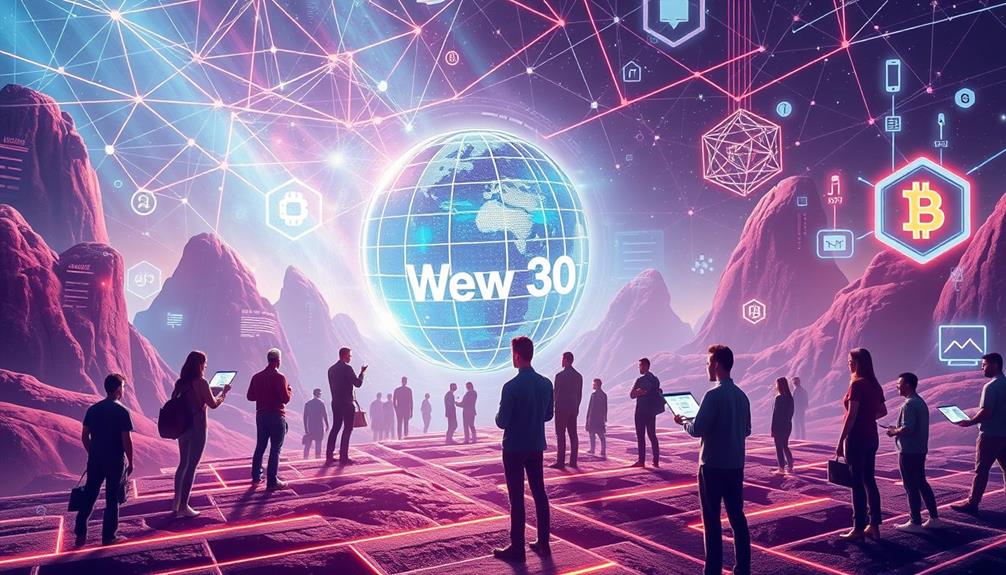
Success in the evolving landscape of digital marketing requires you to adopt effective strategies tailored to Web 3.0. First, prioritize community engagement. By actively involving your audience, you'll gather valuable insights and feedback that enhance your data analytics capabilities, fostering brand loyalty.
Engaging with audiences through comments and social media can build community and increase visibility, especially when leveraging keyword clustering strategies.
Next, leverage decentralized applications (dApps) to guarantee secure and transparent customer interactions. This builds trust and reinforces your brand's credibility.
SEO optimization remains essential in this new digital landscape. Focus on relevant keywords and semantic search tactics to maintain visibility, especially as AI technologies reshape search behavior.
Additionally, consider incorporating NFTs into your marketing strategies. Unique digital assets can attract tech-savvy consumers, as seen with Taco Bell's successful digital taco artwork campaign.
Real-World Web 3.0 Examples
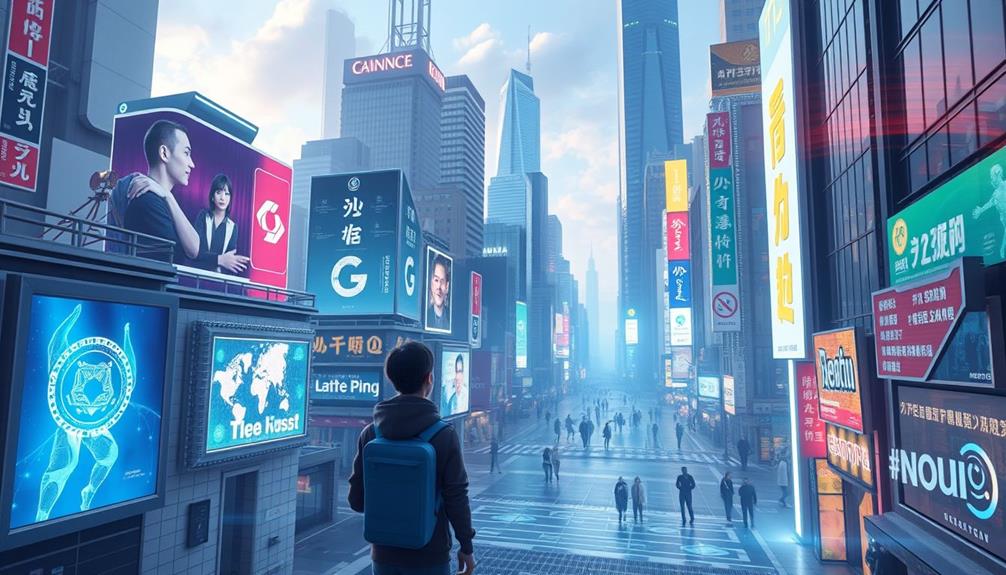
The rise of Web 3.0 has sparked innovative marketing campaigns that blend digital assets with traditional engagement methods.
Take Macy's NFT Parade, for example. They showcased a virtual Thanksgiving Day parade where NFT-based balloons were auctioned, seamlessly integrating digital assets into event marketing. This innovative approach mirrors the potential of diversifying investment portfolios through alternative assets, similar to how the benefits of converting 401k to Gold IRA can enhance financial resilience.
Taco Bell also made waves with its NFT campaign, selling digital taco artwork for just $1 and selling out in under 30 minutes—an impressive feat that highlights the demand for branded digital collectibles.
Samsung's launch of a Discord community exemplifies how brands can leverage decentralized platforms for direct consumer engagement.
Meanwhile, Nike ventured into the metaverse by creating virtual sneakers for avatars, allowing users to buy and wear digital products in immersive environments. This move not only enhances brand presence but also taps into the growing interest in virtual fashion.
Coca-Cola took a unique approach by releasing limited edition NFTs that blend art and brand identity, reinforcing brand loyalty and consumer engagement.
These real-world examples showcase how companies are effectively using digital marketing strategies to adapt to Web 3.0, proving that the future of marketing is indeed digital and decentralized.
Challenges in Digital Marketing

Maneuvering the complexities of digital marketing poses significant challenges for brands looking to engage consumers effectively. One major hurdle is the shift away from third-party cookies, with 63% of digital marketing leaders struggling to provide a personalized user experience. This creates a pressing need for innovative marketing solutions that can adapt to new data collection methods while respecting data privacy and security regulations like GDPR.
Additionally, as businesses explore risk management tactics to protect their investments, they must also consider how these strategies can enhance their marketing efforts.
Furthermore, the rapid evolution of web technology means you must stay on top of changing consumer expectations and emerging trends. Increased competition in the digital landscape requires continuous skill development and the constant adaptation of marketing strategies. If you fail to keep pace, your brand risks being overshadowed.
As global spending on digital marketing is projected to rise from $522.5 billion in 2023 to $836 billion by 2026, the stakes are higher than ever. You'll need to embrace new approaches while addressing the challenges in digital marketing to carve out a competitive edge.
Balancing innovation with transparency in your marketing efforts will be essential to meet the demands of today's consumers and thrive in this dynamic environment.
Preparing for the Future

Steering through the challenges in digital marketing today sets the stage for preparing for the future with Web 3.0. To thrive, you need to grasp blockchain technology, as it guarantees data security and transparency while enabling decentralized applications that will reshape your marketing strategies.
Embracing continuous learning—like courses on AI and machine learning—will also be vital, especially since 84% of digital marketers find that these technologies enhance real-time personalization efforts. Additionally, leveraging effective email marketing strategies can greatly boost your outreach and engagement in this new landscape.
As you adapt, keep in mind the stricter data privacy regulations requiring explicit user consent for data collection. In this evolving landscape, consumer trust is paramount. Focus on community-driven marketing, engaging directly with your audience to build loyalty and gain insights into their preferences.
With digital marketing spending projected to soar from $522.5 billion in 2023 to $836 billion by 2026, leveraging Web 3.0 technologies isn't just smart; it's critical to remain competitive and relevant. By preparing now, you'll position yourself to navigate the future of marketing effectively while meeting the demands of an increasingly savvy consumer base.
Conclusion
As you dive headfirst into the vibrant world of Web 3.0, imagine a marketing universe where your brand shines like a thousand suns, dazzling your audience with personalized experiences that seem almost magical. You'll harness the power of decentralized networks, crafting strategies that feel like they were plucked from a sci-fi novel. Embrace the challenges ahead, and watch your brand transform into an unstoppable force, paving the way for a future that's as thrilling as a rollercoaster ride through the cosmos!
Chris, SEO and Keywords Expert & Author: Chris lives and breathes SEO. With a deep understanding of keyword research and strategy, he’s our go-to guru for everything related to search rankings. Chris has a knack for identifying trends and opportunities in the SEO world, making him an invaluable asset to our team and our clients.
-

 Holistic SEO3 months ago
Holistic SEO3 months agoHolistic Local SEO Tactics for Small Businesses
-

 Holistic SEO2 months ago
Holistic SEO2 months agoHow to Establish Dominance in SEO through Topical Authority
-

 Holistic SEO3 months ago
Holistic SEO3 months agoKeyword Research (SEO) for Tattoo Artists
-

 Learning Center3 months ago
Learning Center3 months ago52 Niches with Good Crossover Potential Explored
-

 Learning Center2 months ago
Learning Center2 months agoThe Future of SEO: Leveraging the Google Search Generative Experience
-

 Holistic SEO3 months ago
Holistic SEO3 months agoHolistic SEO Food Blogger
-

 Keyword Research2 months ago
Keyword Research2 months agoMastering SEO: How to Analyze Keyword Results and Find Easy Keywords
-

 Technical SEO2 months ago
Technical SEO2 months agoUnlock Your Site’s Potential with a Comprehensive Website Audit






















